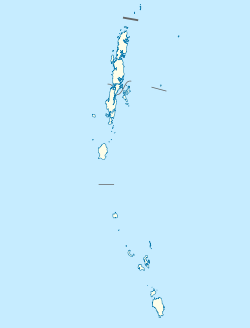
The Austroasiatic languages are a large language family spoken throughout mainland Southeast Asia, South Asia and East Asia. These languages are natively spoken by the majority of the population in Vietnam and Cambodia, and by minority populations scattered throughout parts of Thailand, Laos, India, Myanmar, Malaysia, Bangladesh, Nepal, and southern China. Approximately 117 million people speak an Austroasiatic language, of which more than two-thirds are Vietnamese speakers. Of the Austroasiatic languages, only Vietnamese, Khmer, and Mon have lengthy, established presences in the historical record. Only two are presently considered to be the national languages of sovereign states: Vietnamese in Vietnam, and Khmer in Cambodia. The Mon language is a recognized indigenous language in Myanmar and Thailand, while the Wa language is a "recognized national language" in the de facto autonomous Wa State within Myanmar. Santali is one of the 22 scheduled languages of India. The remainder of the family's languages are spoken by minority groups and have no official status.
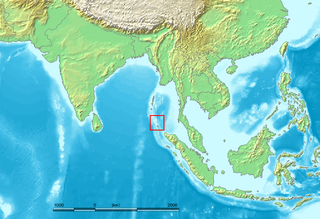
The Nicobar Islands are an archipelagic island chain in the eastern Indian Ocean. They are located in Southeast Asia, 150 kilometres (93 mi) northwest of Aceh on Sumatra, and separated from Thailand to the east by the Andaman Sea. Located 1,300 kilometres (810 mi) southeast of the Indian subcontinent, across the Bay of Bengal, they are part of India, as the Nicobar district within the union territory of the Andaman and Nicobar Islands.
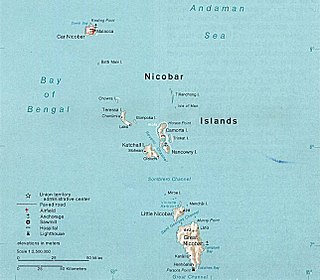
The Nicobarese languages or Nicobaric languages, form an isolated group of about half a dozen closely related Austroasiatic languages, spoken by most of the inhabitants of the Nicobar Islands of India. They have a total of about 30,000 speakers. Most Nicobarese speakers speak the Car language. Paul Sidwell (2015:179) considers the Nicobarese languages to subgroup with Aslian.

The Shompen or Shom Pen are the indigenous people of the interior of Great Nicobar Island, part of the Indian union territory of Andaman and Nicobar Islands.

The Aslian languages are the southernmost branch of Austroasiatic languages spoken on the Malay Peninsula. They are the languages of many of the Orang Asli, the aboriginal inhabitants of the peninsula. The total number of native speakers of Aslian languages is about fifty thousand and all are in danger of extinction. Aslian languages recognized by the Malaysian administration include Kensiu, Kintaq, Jahai, Minriq, Batek, Cheq Wong, Lanoh, Temiar, Semai, Jah Hut, Mah Meri, Semaq Beri, Semelai and Temoq.
Car is the most widely spoken Nicobarese language of the Nicobar Islands in the Bay of Bengal.
Nicobar district is one of three districts in the Indian union territory of the Andaman and Nicobar Islands. The district's administrative territory encompasses all of the Nicobar Islands, which are located in the Indian Ocean, between the Bay of Bengal and the Andaman Sea. The headquarters of the district is the village of Malacca, located on the island of Car Nicobar.
Ikwerre is an Igboid language spoken primarily by the Ikwerre people, who inhabit certain areas of Rivers State, Nigeria.

Ongan, also called Angan, South Andamanese or Jarawa–Onge, is a phylum which comprises two attested Andamanese languages spoken in the southern Andaman Islands.

Järawa or Jarwa is one of the Ongan languages. It is spoken by the Jarawa people inhabiting the interior and south central Rutland Island, central interior, and south interior South Andaman Island, and the west coast of Middle Andaman Island.
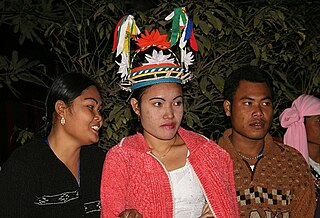
The Nicobarese people are an Austroasiatic-speaking people of the Nicobar Islands, a chain of islands in the Bay of Bengal north of Sumatra, forming part of the union territory of Andaman and Nicobar Islands, India. Only 12 of the 19 islands are inhabited. The largest and main island is Great Nicobar. The term Nicobarese refers to the dominant tribes of the Nicobar Islands. On each island, the people have specific names, but together they are the Nicobarese. They call themselves Holchu, which means "friend".
Proto-Austroasiatic is the reconstructed ancestor of the Austroasiatic languages. Proto-Mon–Khmer has been reconstructed in Harry L. Shorto's Mon–Khmer Comparative Dictionary, while a new Proto-Austroasiatic reconstruction is currently being undertaken by Paul Sidwell.
Kensiu (Kensiw) is an Austro-asiatic language of the Jahaic subbranch. It is spoken by a small community of 300 in Yala Province in southern Thailand and also reportedly by a community of approximately 300 speakers in Western Malaysia in Perak and Kedah states. Speakers of this language are Negritos who are known as the Mani people or Maniq of Thailand.
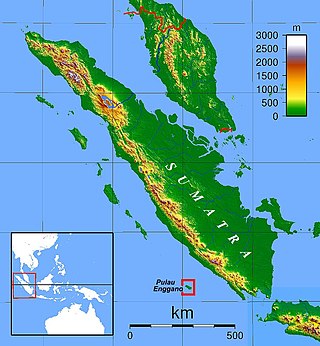
The Enggano language, or Engganese, is an Austronesian language spoken on Enggano Island off the southwestern coast of Sumatra, Indonesia.
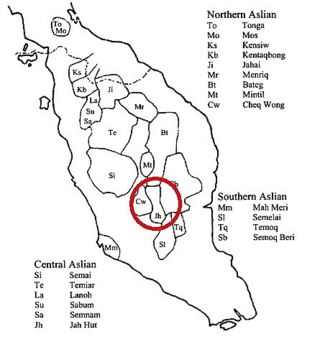
Jah Hut is an Austroasiatic language spoken around the Krau river in peninsular Malaysia. The Jah Hut are one of the indigenous Orang Asli peoples.
Southern Nicobarese is a Nicobarese language, spoken on the Southern Nicobar Islands of Little Nicobar (Ong), Great Nicobar (Lo'ong), and a couple small neighboring islands, Kondul (Lamongshe) and Pulo Milo. Each is said to have its own dialect.
Gbanu is a Gbaya language of the Central African Republic. The people do not consider themselves to be ethnically Gbaya.
Austronesian–Ongan is a controversial proposed language family that would include the Ongan and Austronesian language families. The proposal was first proposed by Juliette Blevins in 2007. Ongan is a small family of two attested languages in the Andaman Islands, while Austronesian is one of the largest language families in the world, originating in Taiwan and spreading throughout the Indian and Pacific oceans. The proposed connection has been rejected by other linguists.
Nancowry is a Nicobarese language spoken on the Nancowry Island in the central Nicobar Islands. It is not mutually intelligible with the other Central Nicobarese languages, and is distantly related to Vietnamese and Khmer,

Frederik Adolph de Roepstorff was a Danish philologist who worked in the Andaman penal colony in India, where he was shot dead by a convict. He studied the languages of Andaman and Nicobar tribes and collected numerous natural history specimens. The Andaman masked owl was named after him by Hume.
